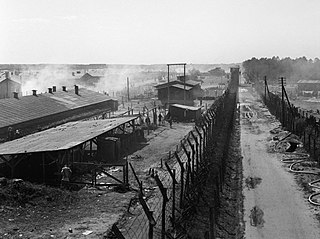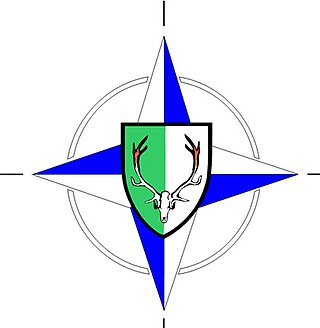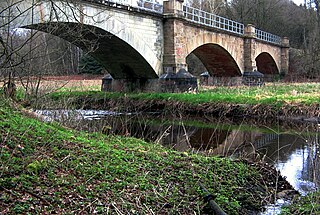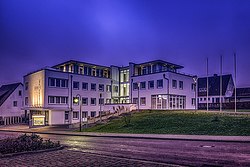
Bergen-Belsen, or Belsen, was a Nazi concentration camp in what is today Lower Saxony in northern Germany, southwest of the town of Bergen near Celle. Originally established as a prisoner of war camp, in 1943, parts of it became a concentration camp. Initially this was an "exchange camp", where Jewish hostages were held with the intention of exchanging them for German prisoners of war held overseas. The camp was later expanded to hold Jews from other concentration camps.

Aufseherin was the position title for a female guard in Nazi concentration camps. Of the 50,000 guards who served in the concentration camps, approximately 5,000 were women. In 1942, the first female guards arrived at Auschwitz and Majdanek from Ravensbrück. The year after, the Nazis began conscripting women because of a shortage of male guards. In the context of these camps, the German position title of Aufseherin translates to (female) "overseer" or "attendant". Later female guards were dispersed to Bolzano (1944–1945), Kaiserwald-Riga (1943–44), Mauthausen, Stutthof (1942–1945), Vaivara (1943–1944), Vught (1943–1944), and at Nazi concentration camps, subcamps, work camps, detention camps and other posts.

Mittelbau-Dora was a Nazi concentration camp located five miles from the town center of Nordhausen in Thuringia, Germany. It was established in late summer 1943 as a subcamp of Buchenwald concentration camp, supplying slave labour from many Eastern countries occupied by Germany, for extending the nearby tunnels in the Kohnstein and for manufacturing the V-2 rocket and the V-1 flying bomb. In the summer of 1944, Mittelbau became an independent concentration camp with numerous subcamps of its own. In 1945, most of the surviving inmates were sent on death marches or crammed in trains of box-cars by the SS. On 11 April 1945, US troops freed the remaining prisoners.

Josef Kramer was Hauptsturmführer and the Commandant of Auschwitz-Birkenau and of the Bergen-Belsen concentration camp. Dubbed the Beast of Belsen by camp inmates, he was a German Nazi war criminal, directly responsible for the deaths of thousands of people. He was detained by the British Army after the Second World War, convicted of war crimes, and hanged on the gallows in the prison at Hamelin by British executioner Albert Pierrepoint.

Bad Fallingbostel is the district town (Kreisstadt) of the Heidekreis district in the German state of Lower Saxony. Since 1976 the town has had a state-recognised Kneipp spa and has held the title of Bad since 2002. It has close ties to Walsrode, a few miles to the west. Until 2015, there was a British Army base in Bad Fallingbostel, It also hosted Defender 2020, the largest US Army/NATO exercise since the Cold War. The town has around 11,000 inhabitants.

The Böhme is a right-bank, northeastern tributary of the Aller in the district of Soltau-Fallingbostel in the north German state of Lower Saxony. The river is 72 kilometres (45 mi) long.

Bergen is a town in the north of Celle district on the Lüneburg Heath, in Lower Saxony, Germany. Administratively it acts as a municipal borough divided into 12 subordinate parishes based on the town and its surrounding villages: Becklingen, Belsen, Bergen, Bleckmar, Diesten, Dohnsen, Eversen, Hagen, Hassel, Offen, Sülze and Wardböhmen. Bergen-Belsen concentration camp was located in the area of Belsen.

Lucille Eichengreen was a survivor of the Łódź (Litzmannstadt) Ghetto and the Nazi German concentration camps of Auschwitz, Neuengamme and Bergen-Belsen. She moved to the United States in 1946, married, had two sons and worked as an insurance agent. In 1994, she published From Ashes to Life: My Memories of the Holocaust. She frequently lectured on the Holocaust at libraries, schools and universities in the U.S. and Germany. She took part in a documentary from the University of Giessen on life in the Ghetto, for which she was awarded an honorary doctorate.

Franz Hößler, also Franz Hössler was a Nazi German SS-Obersturmführer and Schutzhaftlagerführer at the Auschwitz-Birkenau, Dora-Mittelbau and Bergen-Belsen concentration camps during World War II. Captured by the Allies at the end of the war, Hößler was charged with war crimes in the First Bergen-Belsen Trial, found guilty, and sentenced to death. He was executed by hanging at Hameln Prison in 1945.

Gau Eastern Hanover was a regional district of the NSDAP established in 1925 in the north eastern part of the Prussian Province of Hanover, comprising the governorates of Stade and Lüneburg in their then boundaries. Originally called Gau Stade-Lüneburg, it was renamed Gau Ost-Hannover on 1 October 1928. Initially, the Gau was a mere regional Nazi party subsection, but with the growing subjection of all public administration to Nazi party influence after the Machtergreifung, the Gau usurped from 1933 to 1935 more and more the functions of the Provincial government and its superordinate Free State of Prussia. However, after the German constituent states were de facto abolished in 1935, the Gaue replaced them in their responsibilities. Gau East Hannover - like all Nazi party structures - was dismantled after Nazi Germany's defeat in 1945. In 1946 the Control Commission for Germany - British Element (CCG/BE) reconstituted the Province of Hanover as the State of Hanover and later the same year it merged with three smaller neighbouring reconstituted German states to form the new state of Lower Saxony within the British Zone of Occupation. The municipality of Amt Neuhaus was allocated to Mecklenburg-Vorpommern.

Bergen-Hohne Training Area is a NATO military training area in the southern part of the Lüneburg Heath, in the state of Lower Saxony in northern Germany. It covers an area of 284 square kilometres, which makes it the largest military training area in Germany.

The Heath Railway is a regional railway line in North Germany that crosses the Lüneburg Heath from which it derives its name. Most of the line is unelectrified and single-tracked. It links Buchholz in der Nordheide with Hanover, the capital city of Lower Saxony. Together with the east-west Uelzen–Langwedel railway, this north-south line is one of the two most important railways on the heath.

Weltvogelpark Walsrode, known as Walsrode Bird Park or Jubs in English until 2010, is a bird park located in the middle of the Lüneburg Heath in North Germany within the municipality of Bomlitz near Walsrode in the state of Lower Saxony, Germany.

The Bremervörde–Walsrode railway was a railway route of regional importance in the German state of Lower Saxony. It linked Bremervörde via Zeven, Rotenburg (Wümme) and Visselhövede to Walsrode. Passenger trains were divided in Rotenburg. Originally the link was conceived as part of a long-distance through route from Hanover to Geestemünde, but long-distance trains never worked the line.

The Bomlitz is a right-bank tributary of the River Böhme in North Germany. It is just under 18 kilometres (11 mi) long and runs through the Heidekreis district in Lower Saxony.
Benefeld is part of the municipality of Walsrode in the Lower Saxon Heidekreis district in north Germany. Benefeld has a population of 2,232, although its parish covers just 2 km².
Luise Albertz was a German politician committed, throughout her life, to the Social Democratic Party (SPD). She was a member of the West German Bundestag for two decades, until 1969. However, she was firmly rooted in the regional politics of her home city, Oberhausen, where she was the appointed mayor from 1946 to 1948. Following the establishment in 1949, by three of the four principal occupying powers, of West Germany, Albertz was elected mayor of Oberhausen in 1956 and held the office till her death in 1979. She was the first female mayor of a major city in Germany.
Karl Landauer was a German psychoanalyst and co-founder of the first Frankfurt Psychoanalytic Institute. He died of starvation in the Bergen-Belsen concentration camp, Germany.

Der Ort des Terrors. Geschichte der nationalsozialistischen Konzentrationslager is a nine-volume German encyclopedia series of Nazi Germany's camp system, published between 2005 and 2009 by Wolfgang Benz and Barbara Distel for C. H. Beck. It was edited by Angelika Königseder of the Zentrum für Antisemitismusforschung. The first volume deals with central issues concerning the Nazi camp system, volumes 2 to 7 contain articles on the main concentration camps and their subcamps in chronological order. Volume 8 deals with concentration and extermination camps in German-occupied Eastern Europe. Volume 9 also lists other types of camps in the Nazi forced labor camp system.
Albert Kuntz was a German goldsmith, soldier, communist and concentration camp victim. A soldier in the First World War, Kuntz rose to become an elected representative of the German Communist Party in Berlin's Prussian Landtag. In 1933 he was arrested by the Gestapo, and sent to a succession of prisons and concentration camps. He died in January 1945 at the Mittelbau-Dora concentration camp, where he had been organizing the sabotage of the V-2 rocket production line. Following his death, he was revered as an anti-fascist hero in East Germany.




















